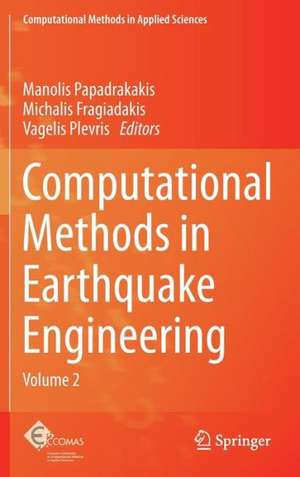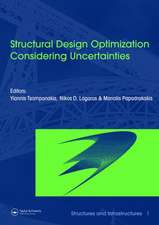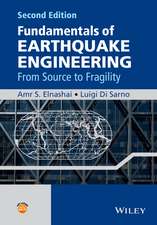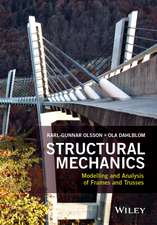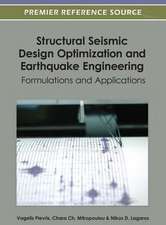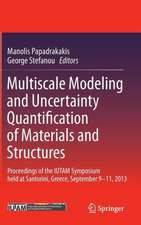Computational Methods in Earthquake Engineering: Volume 2: Computational Methods in Applied Sciences, cartea 30
Editat de Manolis Papadrakakis, Michalis Fragiadakis, Vagelis Plevrisen Limba Engleză Hardback – 14 iun 2013
| Toate formatele și edițiile | Preț | Express |
|---|---|---|
| Paperback (1) | 1233.69 lei 6-8 săpt. | |
| SPRINGER NETHERLANDS – 19 iun 2015 | 1233.69 lei 6-8 săpt. | |
| Hardback (1) | 1239.99 lei 6-8 săpt. | |
| SPRINGER NETHERLANDS – 14 iun 2013 | 1239.99 lei 6-8 săpt. |
Din seria Computational Methods in Applied Sciences
- 15%
 Preț: 655.27 lei
Preț: 655.27 lei - 15%
 Preț: 651.51 lei
Preț: 651.51 lei - 15%
 Preț: 657.73 lei
Preț: 657.73 lei - 5%
 Preț: 709.87 lei
Preț: 709.87 lei - 18%
 Preț: 1116.26 lei
Preț: 1116.26 lei - 18%
 Preț: 947.35 lei
Preț: 947.35 lei - 18%
 Preț: 1224.54 lei
Preț: 1224.54 lei - 18%
 Preț: 952.89 lei
Preț: 952.89 lei - 18%
 Preț: 947.35 lei
Preț: 947.35 lei - 20%
 Preț: 653.38 lei
Preț: 653.38 lei - 18%
 Preț: 954.45 lei
Preț: 954.45 lei - 15%
 Preț: 638.76 lei
Preț: 638.76 lei - 18%
 Preț: 1005.74 lei
Preț: 1005.74 lei - 20%
 Preț: 648.59 lei
Preț: 648.59 lei - 18%
 Preț: 954.45 lei
Preț: 954.45 lei - 20%
 Preț: 640.19 lei
Preț: 640.19 lei - 18%
 Preț: 1231.16 lei
Preț: 1231.16 lei - 24%
 Preț: 789.36 lei
Preț: 789.36 lei - 18%
 Preț: 946.41 lei
Preț: 946.41 lei - 20%
 Preț: 567.62 lei
Preț: 567.62 lei - 15%
 Preț: 639.25 lei
Preț: 639.25 lei - 18%
 Preț: 952.57 lei
Preț: 952.57 lei - 15%
 Preț: 636.80 lei
Preț: 636.80 lei - 15%
 Preț: 650.69 lei
Preț: 650.69 lei - 18%
 Preț: 952.26 lei
Preț: 952.26 lei - 5%
 Preț: 716.65 lei
Preț: 716.65 lei
Preț: 1239.99 lei
Preț vechi: 1512.18 lei
-18% Nou
Puncte Express: 1860
Preț estimativ în valută:
237.35€ • 249.35$ • 199.47£
237.35€ • 249.35$ • 199.47£
Carte tipărită la comandă
Livrare economică 11-25 martie
Preluare comenzi: 021 569.72.76
Specificații
ISBN-13: 9789400765726
ISBN-10: 940076572X
Pagini: 652
Ilustrații: XV, 636 p.
Dimensiuni: 155 x 235 x 40 mm
Greutate: 1.08 kg
Ediția:2013
Editura: SPRINGER NETHERLANDS
Colecția Springer
Seria Computational Methods in Applied Sciences
Locul publicării:Dordrecht, Netherlands
ISBN-10: 940076572X
Pagini: 652
Ilustrații: XV, 636 p.
Dimensiuni: 155 x 235 x 40 mm
Greutate: 1.08 kg
Ediția:2013
Editura: SPRINGER NETHERLANDS
Colecția Springer
Seria Computational Methods in Applied Sciences
Locul publicării:Dordrecht, Netherlands
Public țintă
ResearchCuprins
Preface.- 1. 1D harmonic response of layered inhomogeneous soil: Exact and approximate analytical solutions, by G. Mylonakis, E. Rovithis, Ch. Paraschakis.- 2. Monitored incoherency patterns of seismic ground motion and dynamic response of a long cable-stayed bridge, by V. Lekidis, S. Papadopoulos, Ch. Karakostas, A. Sextos.- 3. An Efficient Beam-Column Element for Nonlinear 3D Frame Analysis, by S. Kostic, F. C. Filippou, Ch. L. Lee.- 4. Floor Response Spectra for Moderately Heavy Nonstructural Elements Attached to Ductile Frame Structures, by Ch. Adam, T. Furtmuller, L. Moschen.- 5. Seismic Assessment of Steel Moment Frames Using Simplified Nonlinear Models, by D. Lignos, Ch. Putman, H. Krawinkler.- 6. Preliminary Seismic Assessment Method for Identifying Reinforced Concrete Structural Failures, by S. Pardalopoulos, G. Thermou, S. Pantazopoulou.- 7. Numerical Determination of the Seismic Strength of Reinforced Concrete Shear Walls with Fractal Cracks, by O. Panagouli, E. Mistakidis, K. Iordanidou.- 8. Damage Analysis of Reinforced Concrete Structures with Substandard Detailing, by P. E. Mergos, A. Kappos.- 9. Seismic Evaluation of Existing Basement Walls, by M. Taiebat, L. Finn, C. Ventura, E. Amirzehni.- 10. Modelling of Infilled Framed Structures, by P. Asteris, Ch. Chrysostomou, I. Giannopoulos, P. Ricci.- 11. Numerical evaluation of the seismic efficiency of connections of fractures and complements of ancient colonnades, by M. E. Dasiou, I. Psycharis, A. Vrouva.- 12. Seismic Overturning of Rocking Structures with External Viscous Dampers, by E. Dimitrakopoulos, M. DeJong.- 13. Innovative computing environment for fast and accurate prediction of approximate IDA curves, by I. Perus, R. Klinc, M. Polenc, M. Dolsek.- 14. Improving static pushover analysis optimizing bilinear fitting of capacity curves, by F. De Luca, D. Vamvatsikos, I. Iervolino.- 15. Collapse Fragility Curves of RC Frames with Varying DesignParameters, by I. Gkimousis, Vl. Koumousis.- 16. Seismic risk assessment of Italian school buildings, by B. Borzi, P. Ceresa, M. Faravelli, E. Fiorini, E. Onida.- 17. Nonlinear dynamic response of MDOF cable nets estimated by equivalent SDOF models, by I. Vassilopoulou, Ch. Gantes.- 18. Non-Linear Dynamic Behaviour of a Ball Vibration Absorber, by J. Naprstek, C. Fischer, M. Pirner, O. Fischer.- 19. Evaluation of response of an isolated system based on double curved surface sliders, by Ch. Casarotti, M. Furinghetti, A. Pavese.- 20. Numerical investigation of the effectiveness of rubber shock-absorbers as a mitigation measure for earthquake-induced structural poundings, by P. Polycarpou, P. Komodromos.- 21. Seismic design methodology for control of 3d buildings by means of multiple tuned-mass-dampers, by O. Lavan, Y. Daniel.- 22. Comparison of innovative base isolation retrofitting technology with conventional retrofitting of existing buildings, by M. Melkumyan.- 23. Preliminary design of seismically isolated r/c bridges – features of relevant expert system and experimental testing of elastomeric bearings, by G. Manos, S. Mitoulis.- 24. Soft Computing in Structural Dynamics, by T. Burczynski, R. Gorski, A. Poteralski, M. Szczepanik.- 25. Optimal design of rc frames using nonlinear inelastic analysis, by B. Gencturk, Kazi Ashfaq Hossain.- 26. Nonsmooth and nonconvex optimization for the design and order reduction of robust controllers used in smart structures, by A. J. Moutsopoulou, A. T. Pouliezos, G. E. Stavroulakis.- 27. A Risk-based Decision Making Methodology for Planning and Operating Safe Infrastructure Systems against Various Hazards, by Y. Xenidis, D. Angelides.- 28. On practical performance of a technique for more efficient dynamic analysis in view of real seismic analysis of a bridge structures, by A. Soroushian, M. Hosseini, A. Vasseghi.- Author Index.
Textul de pe ultima copertă
This book provides an insight on advanced methods and concepts for the design and analysis of structures against earthquake loading. This second volume is a collection of 28 chapters written by leading experts in the field of structural analysis and earthquake engineering. Emphasis is given on current state-of-the-art methods and concepts in computing methods and their application in engineering practice. The book content is suitable for both practicing engineers and academics, covering a wide variety of topics in an effort to assist the timely dissemination of research findings for the mitigation of seismic risk. Due to the devastating socioeconomic consequences of seismic events, the topic is of great scientific interest and is expected to be of valuable help to scientists and engineers. The chapters of this volume are extended versions of selected papers presented at the COMPDYN 2011 conference, held in the island of Corfu, Greece, under the auspices of the European Community on Computational Methods in Applied Sciences (ECCOMAS).
Caracteristici
State-of-the-art methods and concepts in Earthquake Engineering Combination of computing methods and their applications in seismic design and analysis methods Contributions by experts in the field Includes supplementary material: sn.pub/extras
